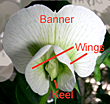Monterey Cypress
Cupressus macrocarpa
Cypress family (Cupressaceae)
Post-Cook introduction
Medium-sized to large introduced aromatic tree with small scalelike leaves. Trunk straight, to 110 ft (34 ) high and commonly 2 1⁄2 ft (0.8 ) in diameter, with conical or spreading Bark dark gray, rough, thick, furrowed into flat ridges. Inner bark is light brown with outer dark brown layer, slightly bitter, resinous. Twigs slender, 4-angled.

©2005 Richard Wang
Female (seed-bearing) cones clustered on short stalks, rounded, 1-1 1⁄2 inches (2.5–4 ) in diameter, brownish, maturing second year and remaining attached. Cone- 8–14, shield-shaped, rounded at edges, with raised point in center. Seeds about 140 per cone, 3⁄16 inch (5 ) long, light brown, angled, with several glanddots and with a narrow Male (pollen) cones on the same tree, oblong, 1⁄8 inch (3 ) long, yellow.
Heartwood, yellowish brown, is not readily distinguished from the sapwood. The fine-textured, slightly aromatic wood is moderately lightweight ( gr. 0.40). Strong and suited to most types of construction, but reported to lack durability in ground contact (Streets 1962). A small amount of lumber has been sawn in Hawaii, and the wood was used for general construction. Logs of large trees are relatively knot-free, but are deeply fluted, making lumber grade yield quite poor.
This species, distinguished by the larger cones, is the most common cypress in Hawaii and is most frequently seen as a large tree at old homestead sites in the uplands. Widely planted in the Forest Reserves on all islands: more than 216,000 trees were planted between 1910 and 1960. It grows well at 1500–5000 ft (457–1524 ) altitude in most areas and may be seen at Kokee, Kauai, Waihou Spring (Olinda), Maui, and at Waimea and Volcano Village on Hawaii.
Elsewhere, the trees have been planted widely for ornament, hedges, and windbreaks, not only in the Pacific States, but in warm temperate parts of Europe, South America, Australia, and New Zealand. However, this species is no longer recommended in the Pacific States because of a fungus disease.
Champion
Height 85 ft (25.9 ) c.b.h. 27.6 ft (9.4 ), spread 81 ft (24.7 ). Waikoekoe, Waimea Village, Hawaii (1968).
Range
Very rare and local on the Pacific coast near Monterey, California.

